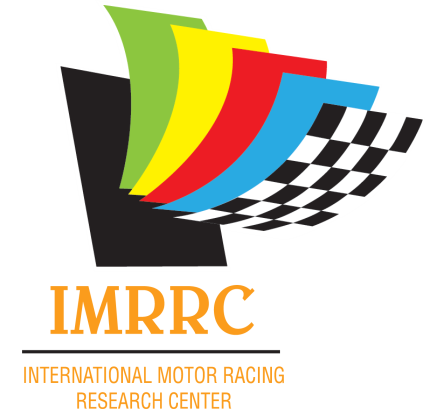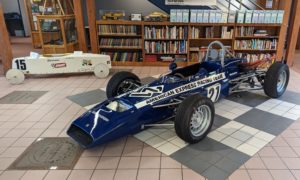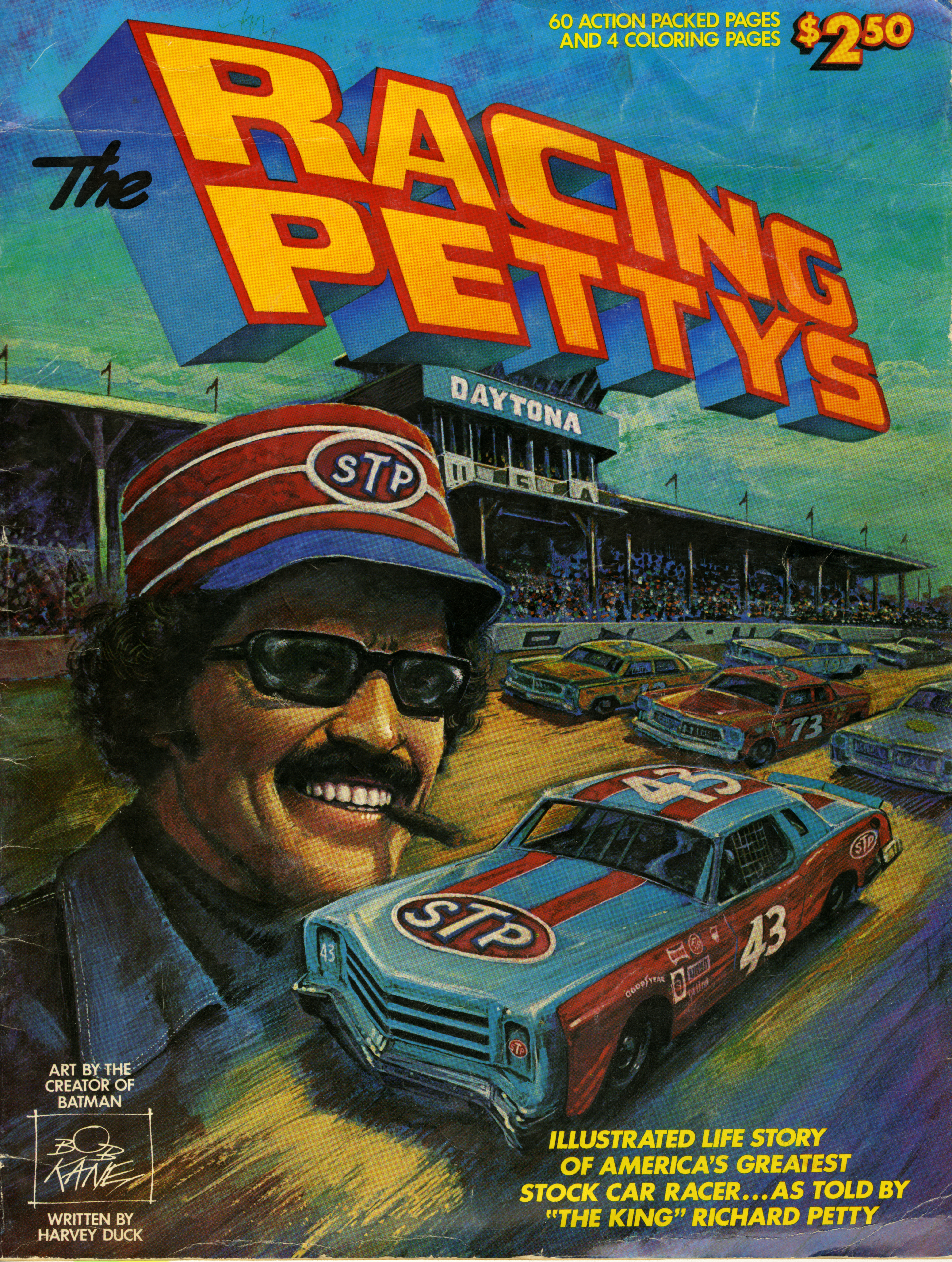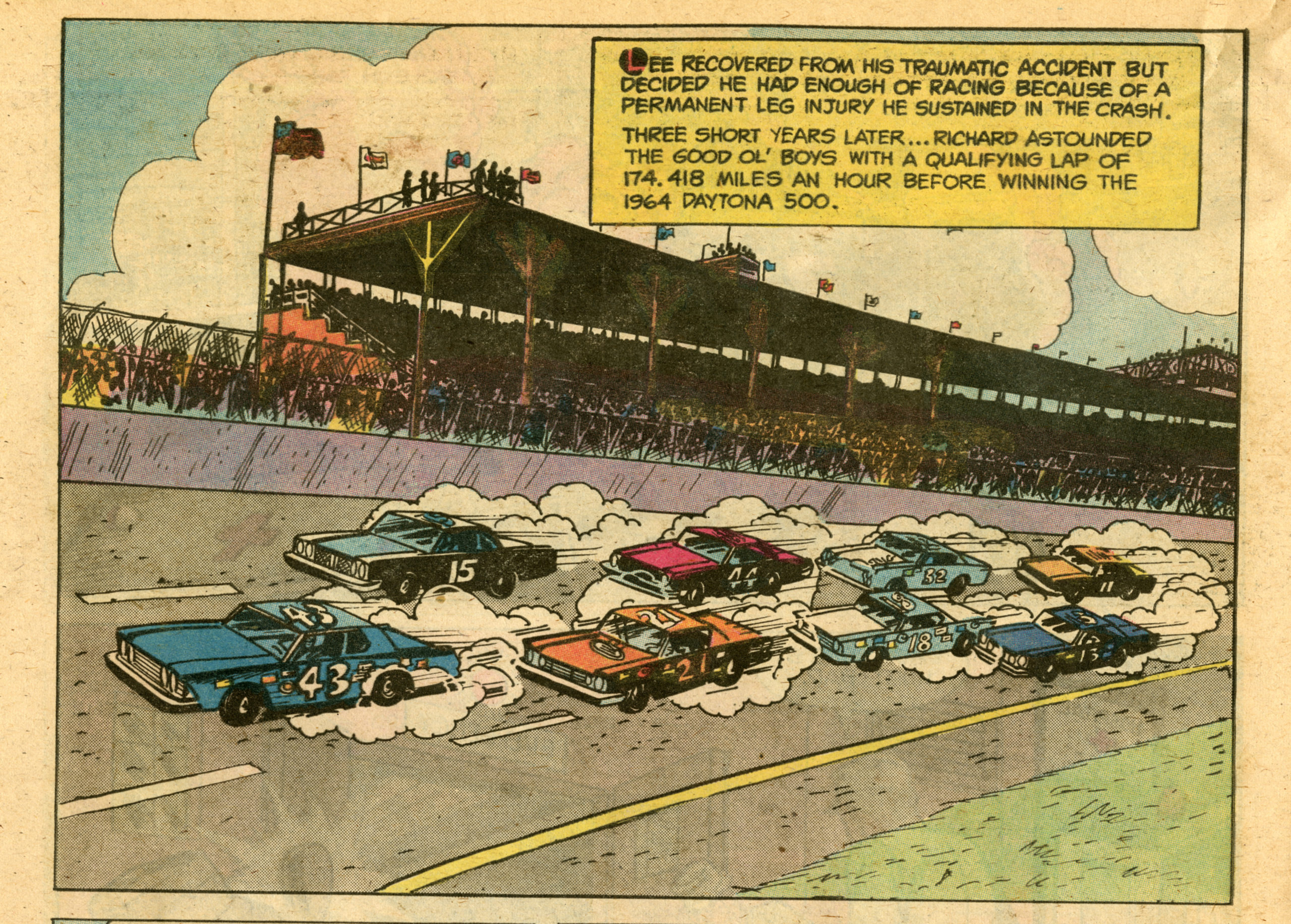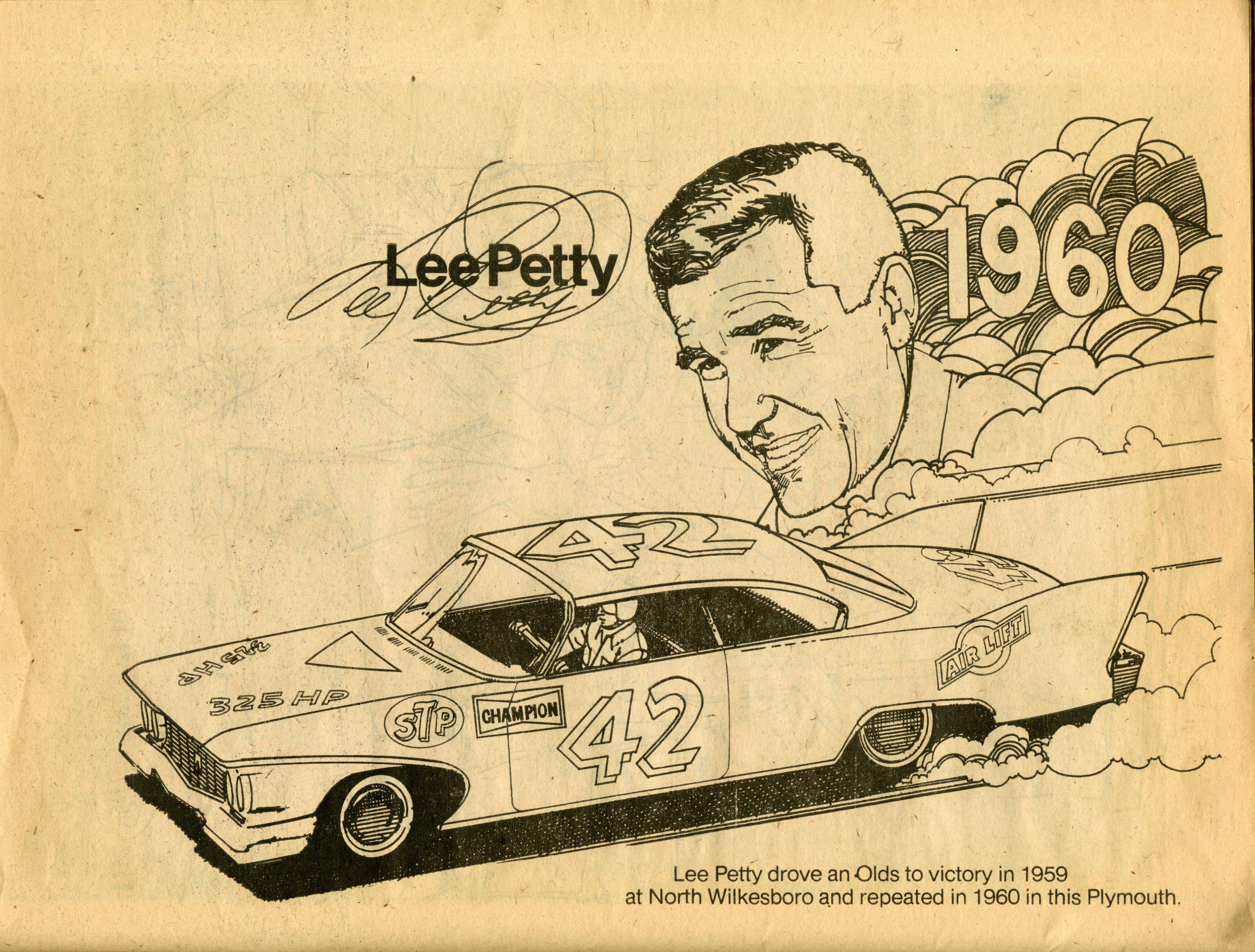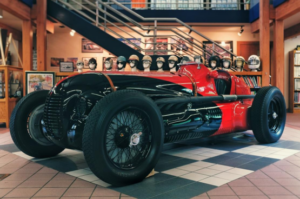An American sports car designed and built by California hot rodders, the Scarab holds a unique place in American road racing history. Funded by Lance Reventlow, heir to the Woolworth fortune, and built by Troutman and Barnes, the Scarab is powered by a small block Chevy from Traco Engineering. The car’s mission was to compete and win against the best European sports cars of the era.
Only three front-engine Scarabs were built in 1958, and they were immediately competitive, winning the SCCA National Championship in 1958. Driven by such notable drivers as Augie Pabst, Chuck Daigh, Reventlow himself, and the legendary Carroll Shelby, the Scarab competed – and won – at road courses around the country from the late 1950s to the mid-1960s.
Our MK 1 “Recreation” was originally owned by a noted collector, Larry Wilson of Jupiter, FL. We want to thank the current owner, John Petris of Tyrone, NY, for the opportunity to have this spectacular example of sports car racing history on display here at the Research Center.
New on the grid! The 1973 BMW 2002 currently owned by Bennie Bish from Whitney Point, NY. It has raced in the SCCA E Production class. Bennie purchased the car from Marc Feinstein in Boston. Stop in any time to take a look! We’re open 9-5 during the week, with special hours this Saturday, May 20th, 10-4 for our Center Conversation.
Donated to the IMRRC by Dr. Gary George. Swipe left/right, use the dots at the bottom or left/right arrows to navigate this slideshow.
Download / View the article from the SCCA.
The International Motor Racing Research Center will help support New York State’s “Path Through History” weekend this Saturday, October 9th. Visitors to the Center will experience “A Lap Back to the Past.” On display is a 1967 Lotus Formula Ford – the car that launched the careers of many engineers, technicians, and a long list of famous drivers. Check out the short film “25 Years At Speed” to learn how and why Watkins Glen is known as the “Birthplace of American Road Racing.” The Center is all about preserving the history of racing. Add us to your list and take a step back in time. Saturday hours will be from 10 a.m. to 4 p.m. and admission is free.
WATKINS GLEN, N.Y. (March 12, 2020) – The International Motor Racing Research Center (IMRRC) will host several exhibitions this year that tell the story of women in United States motorsports.
The first exhibition, Trackside Stories: Kathie J. Meredith’s Motorsports Photographs, 1968-1972, will be mounted by the IMRRC in collaboration with the Arnot Art Museum in Elmira, NY. The show, on display at the Arnot from March 24, 2020, through June 27, 2020, will feature 30 motorsports photographs by photojournalist Kathie J. Meredith. Meredith, a photographer and writer with the Daily Messenger newspaper in Canandaigua, NY, covered races at the Watkins Glen International racetrack during the most exciting era in the circuit’s history, when it hosted major national racing events as well as top-level international races in the prestigious Formula One series. Her motorsports photographs tell a myriad of stories found trackside – of fans, track workers, and internationally-famous racecar drivers. The images on display are drawn from part of a collection donated by Meredith to the IMRRC.
“Meredith’s images are a significant body of work by a female sports photographer during the ‘golden age’ of racing at the Glen,” said Jenny Ambrose, head archivist at the IMRRC. “At the time, there were few women photographers at the track, and very few were granted access to drivers and pits.” The exhibition of Meredith’s photographs is part of a larger project undertaken by the IMRRC in 2020 to celebrate the contributions of women to motorsports. In May, the Center will present the primary exhibition Women of Speed: Legacies in Motorsports at its visitors’ center at 610 South Decatur in Watkins Glen with smaller complementary displays in satellite locations throughout the village. Women of Speed will include
objects from the collection related to women in racing, such as helmets, trophies, race results and photographs – all to help tell the story of women’s involvement in racing over time, both behind the scenes and on the track.
“The IMRRC is one of the best collections of motorsports history in the world and we want to use our collections to bring the stories of motor racing to life,” said Dan DeRusha, the Research Center’s executive director. “We are very excited to showcase objects from our archives in a way that tells the often-overlooked stories of the contributions women have made to the world of motorsports.” The exhibitions and related programming are made possible by grants from the Community Foundation of Elmira-Corning and the Finger Lakes. Both exhibitions coincide with the centennial of American women’s suffrage.
About the International Motor Racing Research Center (IMRRC)
Located in one of the premier racing towns in America, the IMRRC’s collection spans continents, eras, and race series, embodying the speed, drama and camaraderie of amateur and professional motor racing throughout the world. The Center welcomes serious researchers and casual fans alike to share stories of race drivers, race series, and race cars captured on its shelves and walls and brought to life through exhibitions and special events. The IMRRC is free and open to the public, no appointment necessary, Monday-Friday, 9 a.m.-5 p.m. More at racingarchives.org.
About the Arnot Art Museum
Founded with the bequest by Matthias H. Arnot of his collection, home, and an endowment in 1910, the Arnot Art Museum in Elmira, NY, has grown to become one of the leading cultural institutions in the region. The mission of the Arnot Art Museum is to preserve the original collection of Matthias H. Arnot and, with a primary focus on representational art, to collect and exhibit works of art possessing the highest quality, merit, enduring worth, and interest. The Museum is open Tuesday-Friday, 10 a.m.-5 p.m. and Saturday, 12-5 p.m., and admission is $7 for adults. More at arnotartmuseum.org.
Download the Full Press Release.

Pete Argetsinger, co-driver of the Polimotor Lola T-616 powered by the world’s first plastic racing engine. Argetsinger, returning to the United States after 10 years of racing and living in Europe, has raced Formula Fords, sedans, and Formula 3 in Europe. He won the British Kentagon Formula Ford Championship in 1980.
The legendary Nurburgring race track was the site of many of the greatest sports car, formula car, and motorcycle races of the 20th Century. Predecessor of the current, much shorter, Grand Prix circuit it was completed in 1925. In its’ early configuration, the “Ring” wound dramatically for more than 17 miles through the heavily wooded Eifel Mountains in the Rhineland-Palatinate of Germany. With elevations varying more than 1,000 feet and 174 bends, the circuit was enormously challenging to drivers and became increasingly so as the performance characteristics of race cars evolved.
Until the Ring’s sad demise under the financial burdens of modern Formula One organizational demands, the venerable circuit was synonymous with the German Grand Prix. The mecca of motor racing for forty-nine years, the track hosted legendary drivers from the ultimate “Ringmeister” Rudolf Caracciola to the victor at its final Grand Prix, James Hunt, in 1976. Other Ringmeisters (the term for repeat winners) included Alberto Ascari, Juan Manuel Fangio, Tony Brooks, Jackie Stewart, John Surtees and Jacky Ickx. Nearly every famous name associated with motor sports in the 20th Century can be found in the entry lists of the Ring.
Werner Winter is a German publisher and former Automobil Club von Deutschland (AvD) official, long associated with Nurburgring and its successor venue for the German Grand Prix, Hockenheimring. He chose the IMRRC as the repository for his working papers. Winter’s collection of the Nurburgring magazine, dating from 1927 through his own tenure as publisher in the 1970’s, is stunning – comprised of 76 meticulously preserved individual issues of this prestigious periodical, famous for dramatic cover art, with lavish illustrations and photography accompanying its fine articles and written features. Together with pristine-condition race programs for nearly every race held at Nurburgring from May 1928 to August 1975, these beautifully designed and illustrated publications constitute what may be the most complete collection of Nurburgring printed materials extant.
These rewarding gems, however, are only a portion of the Werner Winter Collection. A publisher of multi-lingual trade directories for the paper, plastic and automotive industries, Winter (b. 1937) also has a long-time involvement with motor racing as a businessman, publicity expert and aficionado. For two years he published the Nurburgring and Hockenheimring magazines and was for many years involved in promotional publicity for Hockenheimring and Nurburgring, He developed creative techniques for marketing motor racing events, especially among American servicemen who constituted a large potential audience in West Germany during the 1960’s and 1970’s.
As a result of Winter’s public relations efforts, the collection includes an extensive compilation of promotional materials for Nurburgring races from 1968 to 1987 and Hockenheimring races from 1968 to 1996. Organized chronologically, these nine large binders include race programs, posters, tickets, photographs and press releases.
Winter’s collection is uniquely valuable as the repository of the publisher’s working files for Nurburgring magazine (1976-1979) and Hockenheimring magazine (1971-1972). Winter recalls that “since motor sport was both fun and business for me, I signed a contract with the Hockenheim track owners to publish the Hockenheimring magazine….I was happy and proud to run articles from almost any known member of the International Racing Press Association, Denis Jenkinson (the greatest of them all), Peter Lyons, Nigel Roebuck, Eoin Young, etc., illustrated by the brilliant pictures of artists like Rainler Schlegelmilch.” The working files contain a wealth of original photographs, slides, correspondence, notes, and printed materials used in preparation of each bi-annual issue.
A respected figure in the racing world, Winter’s professional talent is complimented by his zest for life and sense of humor. Reflecting on his motor racing experiences, Winter writes, “At the races I spent most of my time in the good company of my best friend for almost forty years, Randy Barnett [whose remarkable collection also resides in the IMRRC], motorsports editor of the Darmstadt based Stars & Stripes. The motor sport editors were in those days a real brotherhood. Extremely funny guys, the first to enter and the last to leave bars at Monza, Brands Hatch, Zolder and Nurburgring.”
The contents are open to researchers and others interested in this fascinating era of racing history. Those who wish to access the collection may contact the IMRRC to schedule an appointment.
WATKINS GLEN, N.Y. (Aug. 29, 2018) – The International Motor Racing Research Center has two rare and historically significant race cars on exhibit starting in early September.
The cars will be on display to coincide with the dates of the 2018 Grand Prix Festival taking place on Friday, Sept. 7, and the weekend-long Hilliard United States Vintage Grand Prix at Watkins Glen International. The cars can be seen at the IMRRC Visitors Center at 610 S. Decatur Street in Downtown Watkins Glen. Exhibit hours are 9 a.m.-5 p.m. daily with extended event hours on Friday Sept. 7, when the Center will be open until 9 p.m. Both cars have long and storied careers that directly relate to the history of racing in Watkins Glen.
“Poison Lil,” built in 1936, is one of four Maserati V8RIs made. Originally designed by Ernesto Maserati, the V8RI was intended to compete with the German race cars of the
time. After limited success in the European Grand Prix circuit, all four Maseratis went on to race in other venues over the next few decades.
The 1952 OSCA MT4, which will temporarily leave the Center to participate in Friday downtown festival events, is also a product of the Maserati family. O.S.C.A. (Officine Specializzate Costruzione Automobili) was founded by Earnesto Maserati and two of his brothers in 1947. The company made racing and sports cars until 1967. The MT4, the first of OSCA’s production models, was incredibly successful at racing venues throughout the world. In fact, one of its most prominent wins was the 12 Hours of Sebring race in 1954 driven by Stirling Moss and Bill Lloyd.
Poison Lil had an amazingly long career racing in the United States. Built as chassis number 4504, it was driven by “Raph” (the Marquis George Raphael Berthenod da las Casas) in the 1936 Vanderbilt Cup in Nassau County on Long Island, New York. It competed again at that race the following year with Mauri Rose behind the wheel. The car was driven by Henry Banks at the the Indianapolis 500 in 1938 and again in ’39. After World War II, George Weaver purchased the car for use at Sports Club of America events. Weaver campaigned the car at Watkins Glen from 1948 through 1955. In fact, he led the first competitive lap at Watkins Glen in the 1948 “Junior Prix.” Both he and the car later won the Seneca Cup in 1949 and again in 1951.
“These cars have incredible historical context,” says IMRRC Visitor Experience Coordinator, Kip Zeiter. “Poison Lil opened the door by leading lap one at Watkins Glen in ’48 and the OSCA took the checkered flag at the last completed race in 1952.” Zeiter went on to explain that while there was another race, it was never completed due to the accidental death of a fan. “After 1952, racing moved from the streets up the hill to a more closed circuit. It was the end of an era.”

#82 Bill Spear in his OSCA on his way to winning the 1952 Queen Catharine Cup Race at Watkins Glen. Photo: Courtesy of Bill Green
The OSCA MT4 was purchased by William (Bill) C. Spear to race in Sports Car Club of America events. In his first race with the car, Spear took the checkered flag at the 1952 Kimberly Cup race in Elkhart Lake, Wis.
Spear’s next race brought the OSCA to Watkins Glen for the SCCA national event on Sept. 20, 1952. In a race shortened due to delays, the number 82 OSCA won the Queen Catharine Cup with an average speed of 72.3 mph.
The Queen Catharine Cup was the second race run that day following the Seneca Cup. In a tragic turn of events, the Watkins Glen Grand Prix which started after Spear’s win was not completed. An accident at the start of the second lap took the life of spectator. That led to the cancellation of the race. Therefore, Bill Spear and his OSCA took the final official checkered flag on the streets of Watkins Glen.
Zeiter, while standing within inches of Poison Lil, sums up the significance of being able to show both cars together, “It’s really an incredible experience. It’s not every day you
can get this close to something with this much history.”
The Racing Research Center is an archival library dedicated to the preservation and sharing of the history of motorsports, of all series and all venues, through its collections of books, periodicals, films, photographs, fine art and other materials. For more information about the Center’s work and its programs, visit www.racingarchives.org or call (607) 535-9044. The Center also is on Facebook at “International Motor Racing Research Center” and on Twitter at “@IMRRCatWG.
